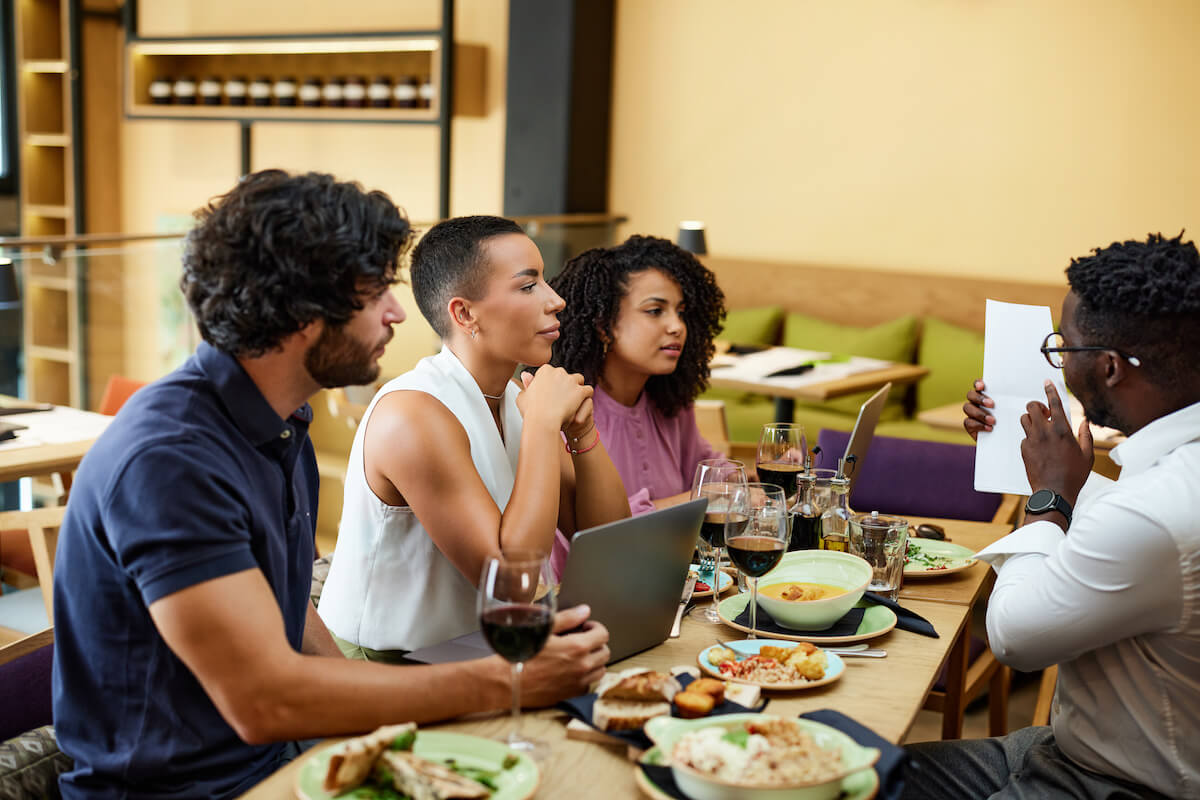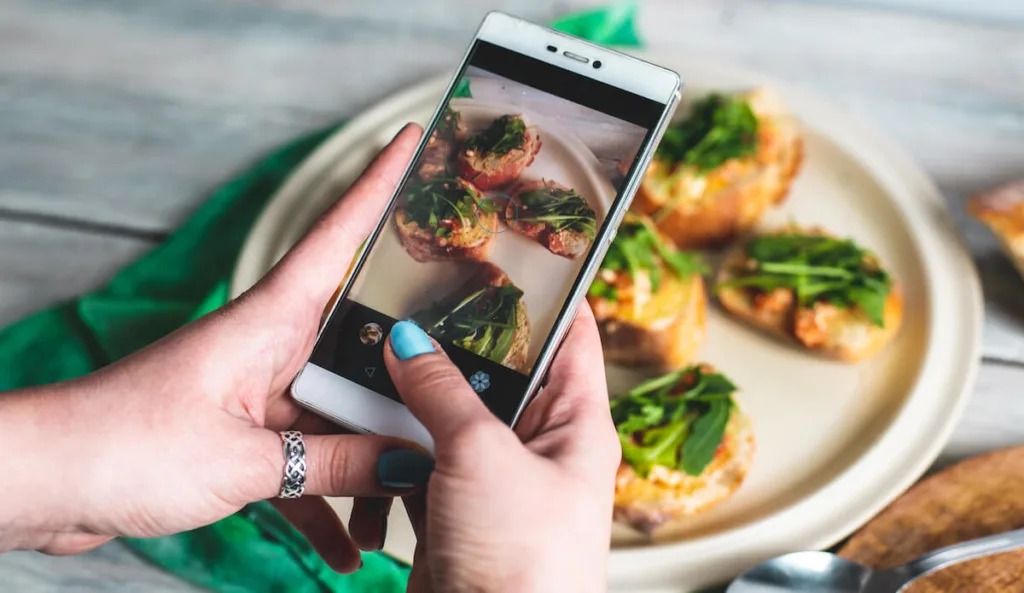Online restaurant advertising: How to win new guests
Skip the article and turn takeaways into action by scheduling a call with our team.
There are times when guests hit up a new restaurant because of word-of-mouth. There are even those rare moments when they just walk into a place without ever being targeted by any form of restaurant marketing. But most of the time, it’s their curiosity paired with their phones, social media, and digital marketing that direct them to where they’ll be eating on any given night.
Restaurant owners know that the current and future state of restaurant advertising is primarily online. While traditional methods are relevant, in this article, we’ll focus on effective online marketing strategies. You’ll walk away with the tools to take your ad campaigns to the next level.
Why is online restaurant advertising important?

The reach of online restaurant advertising is enormous, and most people are potential customers. You can target your demographics with social media marketing and use tools such as Yelp Ads to determine who your demographics are in the first place.
Or, you could tell your loyal customers all about important restaurant promotions through an email marketing subscription service.
Understanding how digital marketing channels work can put you alongside the search results of restaurant industry giants. For instance, by using search engine optimization best practices, you can appear on the first page of Google for search terms you care about.
Online advertising has leveled the playing field and can potentially be way cheaper than advertising in the traditional sense. Now, let’s look at some easy-to-learn yet hard-to-master online restaurant advertising techniques to get you headed in the right direction.
Restaurant marketing strategies: Digital marketing must-haves

Build your restaurant website
A restaurant website is a must-have. Even a hole-in-the-wall pizza joint that’s consistently at capacity can make use of a website. Building a website is a fairly simple task, with templates aplenty and easy-build sites like Squarespace and Wix.
Using local SEO strategies for website copy is a marketing tool all on its own, as it helps drive your restaurant to the top of searches for local restaurant terms. Running Google ads can also get visitors to your website and push you to the top of search results, driving foot traffic.
For your website, the more information you have, the better. High-quality photos, your full menu, info like your phone number and a well-defined “about” section tell first-time viewers a lot about you. The image you craft on your website is a key part of your brand identity, and a major step in building a complete restaurant brand.
If you have skill in building websites and writing web copy, great. If not, there is an entire industry waiting to serve you and make the most of your website—just search for SEO agencies.
Create an email newsletter
An email newsletter keeps loyal customers interested and entices new customers too. You may fear that regular emails appear spammy, but if a customer has signed up voluntarily, they have already shown interest. In general, to not overwhelm your target audience with emails, aim for a monthly newsletter for overall news, and send out emails about limited-time offers or special events as necessary.
An easy way to get opt-ins to your email newsletter is to offer a discount on their next meal by signing up. It could also coincide with the launch of a new loyalty program you are running. This works well since you already know the customer plans to be a regular. Be sure to include incentives like coupons for your email newsletter recipients, to provide some valuable rewards for participating.
If you can afford it, hire a copywriter to set up your email templates and share your marketing plan with them. Use your emails to relay stories about your restaurant or updates like new menu items. Make sure to always end with a call to action that directs the customer back to your restaurant website too.
Emerging restaurant advertising tools: AI-powered ads
AI is the big story in the digital world these days, and restaurants can make the most of the AI revolution through advertising. AI makes what used to be laborious, expensive marketing campaigns cheap and automated, easing burdens on both a restaurateur’s time and wallet.
Here are some ways for restaurants to integrate AI into their advertising:
- Check out tools like adcreative.ai to generate high-performing ads, including marketing copy and videos tailored to your brand.
- Add AI chatbots to your website and socials to answer customer queries and drive reservations.
- Tap into AI-led CRM platforms like Salesforce to send personalized email offers based on customer preferences.
- Many AI tools offer free trials, so shop around and see what seems to save you the most time while offering the highest-quality output.
What happens next in the world of AI is anyone’s guess, but it’s not going anywhere. Make use of the ways it can give you time back so you’re not stuck in the office.
Third-party delivery apps: Free advertising
Millions of people browse food delivery apps every day, and the food delivery business is set to explode at a growth rate of 9.4% per year. So, putting your restaurant on delivery sites can be a great way to attract new customers while earning some extra bucks via delivery.
Customers who may never have heard of you can browse your entire menu and price list by simply stumbling on your name via DoorDash, Uber Eats, or any other third-party app you deem worthy. Treat these as a viable indirect method to reach customers and you may find yourself with increased deliveries and increased walk-in traffic alike.
Social media marketing

Social media is a gold mine for restaurants looking to bolster their business, and it’s non-negotiable for even the best restaurants’ marketing efforts. With the wide variety of platforms out there, keeping up with trends will build brand awareness and be a key part of your restaurant marketing plan.
Leverage video content for engagement
You’ve likely noticed that video content, especially short-form video, is everywhere. Video marketing is riding the crest of that wave, especially for restaurants, as it captures attention and conveys the dining experience vividly. Some key areas to focus on for video content include:
- Storytelling through video: Share your restaurant’s story, like the history, your chef’s inspirations, behind-the-scenes videos of your staff interacting, or your community involvement. This builds your restaurant brand and develops connections with your audience.
- User-generated content: Encourage customers to post videos of their customer experience and reshare them—with permission, of course—to boost authenticity.
- Livestream special events: If you’re hosting special events like live music or cooking classes, stream it on Instagram Live and other platforms to engage followers in real time.
- Tap into free software: Free editing tools like CapCut make polished videos with a minimal learning curve.
Instagram and TikTok are the most valuable short-form video content platforms, especially for reaching younger audiences.
Work with local influencers and get social

Partnering with restaurant influencers is an excellent way to drum up new customers, because influencers provide an excellent return on investment. For every $1 spent, businesses average $6.50 in earnings. When you consider the fact that 1 in 5 restaurant customers look to influencers for recommendations, these returns make sense.
Here’s how to work with influencers. The days of free meals in exchange for a post are largely over — influencers these days know their worth!
- Find influencers by searching the geotags near your restaurant and local foodie hashtags, like #portlandfoodie and #portlandfoodblogger, for example. You can also search “foodie influencers near me” on Google and mine information from articles, Reddit posts, and influencer networks.
- Audit the blogger or influencer’s social media post history. Do their videos align with your brand? Would it fit on your socials if you do a collaborative post?
- Do a quick check of their like-to-follower ratio. Influencers with 100,000 followers but less than 100 likes on a day-old post have bought their followers and don’t have a real, organic following.
- Look at their comments. If the comments all look like bots or have the same combo of emojis, skip it. If their comments have genuine-looking reactions from people who want to try out their recs, that’s a good sign.
- Once you have a shortlist of influencers in your area, reach out to the email in their bio or DM them. Most influencers will send you a package with their rates, statistics about their engagement, content examples, and a contract, and you can get the ball rolling.
Make sure that you include a requirement that they include your hashtags and link back to your socials and restaurant website so diners can easily make a reservation or online order.
Run targeted social media ad campaigns
Paid social media ads can be highly effective at targeting local users based on age, interests, or behaviors. Consider running Facebook ads or Instagram ads for limited-time promotions like happy hour deals or seasonal menus to drive urgency. Start with a small budget of perhaps $10-$20 per day and use ad platform analytics to see what works and what doesn’t and tweak as necessary.
A/B testing is crucial when running a social media ad campaign, so have alternatives at hand and track performance. That means different copy, different visuals, and a different call-to-action. It’s pleasantly surprising to see a home run where you didn’t expect one. So at the start, consider the wet spaghetti method: Throw ads out there and see what sticks to the wall.
Yelp for Restaurants advertising
Yelp is a powerful tool for restaurant marketing in many ways. Using the Yelp platform itself gets your restaurant in front of 95 million hungry diners, and combining your Yelp profile with other tools like Yelp Ads and Yelp Connect further bolsters your presence.
Understand and find your audience with Yelp Ads
![]()
Not everyone browsing social media is interested in your latest restaurant menu, even though they may enjoy an eye-catching picture on your Facebook page. Generally, people are just fulfilling the addictive habit of browsing random user-generated content.
Why not take your restaurant advertising directly to where you know people are looking for a place to eat? Yelp gets 95 million unique visitors monthly, meaning your reach is enormous and direct.
Stay top of mind with Yelp Ads and build customized ads that hit your targeted demographic with chosen SEO and location data. Impressions are free, and you only pay when someone actually clicks your ad (you can set budgets so you don’t overspend on successful campaigns too). You can even track your metrics so you know what’s working and how you should change up your advertising ideas for even better ROI.
Get the most out of positive reviews
Online reviews are gold for restaurants, especially when they’re positive. Customers absolutely read reviews before checking out a new restaurant, as they’re the fast-track for a restaurant to credibility and social proof.
Encourage customers to leave reviews by leaving placards on tables or having staff ask customers to do so. Restaurateurs must respond whenever possible, both to negative and positive reviews. Keeping on top of the review game humanizes a restaurant and builds rapport with customers. Even negative reviews can turn into something good if you handle it with care.
Share your restaurant stories with Yelp Connect

Yelp Connect works well alongside Yelp Ads, and it’s how you turn your Yelp Business Page from just an empty shell to an informative site that feels real. It’s the perfect place to broadcast your new restaurant promotions. New outdoor space? Share it. New high-profile chef? Share it. New sustainable practices? Share it.
Loyal customers who use the Yelp app and email subscription service will receive updates directly to their devices without even checking your page.
Also, just like Yelp Ads, you can see who’s engaging with your posts. You’ll see their demographic information and the neighborhoods they regularly visit.
Max out your reservations with booking links
Yelp Guest Manager users can insert unique booking links into social media posts and ads that take customers directly to your reservation page. As a free-for-use service for Guest Manager customers, these booking links reduce friction to near-zero for hungry customers. The process is simple: Customers see a mouth-watering photo or video of your food while browsing Instagram, then they see a link to your reservation page, they click it, and put their info in. Boom—a new reservation.
Start your online restaurant advertising journey now

Hopefully, reading this article has stirred up some marketing ideas in your mind. Society’s rapid shift to online obsession has created tons of opportunities to create high-quality online restaurant advertisements that are massively more effective and direct than an ad in a random magazine.
An email newsletter can help to create a stronger bond with loyal customers. Your website is your online home, and social media platforms are vital tools to reach new customers. Local influencers could bring a surge in followers and produce all kinds of user-generated content to round out a digital marketing content plan.
A well-promoted restaurant could grow faster than you think. Manage the rush with Yelp Guest Manager, a software solution that allows customers to check themselves in, handles waitlists and reservations, and works in conjunction with your other software.
Restaurants that use Guest Manager paired with Yelp Ads experience 87% more traffic on their Yelp business page.